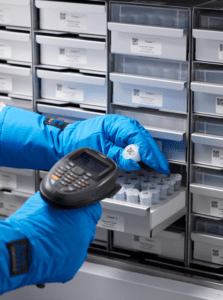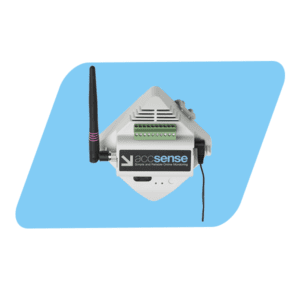High-Valued Specimens Kept Safe By Cryogenic Temperature Measurement
 CAS DataLoggers found the cryogenic freezer temperature data logging solution for a hospital facility relying on multiple cryogenic freezers to safely store high-value samples including blood and medical specimens. Their freezers operated at the frigid temperature of -192°C (-314°F) and were powered by LN2 (Liquid Nitrogen). Unfortunately, they were occasionally prone to fail. While these failures were infrequent, they could be catastrophic, since each freezer could contain as many as 2,000 samples. Therefore, the hospital had an urgent need for a wireless solution to perform constant temperature monitoring for their cryogenic freezers, one capable of real-time remote alarming whenever the temperature rose above acceptable levels to avoid potential losses.
CAS DataLoggers found the cryogenic freezer temperature data logging solution for a hospital facility relying on multiple cryogenic freezers to safely store high-value samples including blood and medical specimens. Their freezers operated at the frigid temperature of -192°C (-314°F) and were powered by LN2 (Liquid Nitrogen). Unfortunately, they were occasionally prone to fail. While these failures were infrequent, they could be catastrophic, since each freezer could contain as many as 2,000 samples. Therefore, the hospital had an urgent need for a wireless solution to perform constant temperature monitoring for their cryogenic freezers, one capable of real-time remote alarming whenever the temperature rose above acceptable levels to avoid potential losses.
Installation
The hospital installed an Accsense A1-02b Temperature Pod for each freezer, placing the pods directly on top of every cold storage unit. Each pod was then connected via its separate miniature TC connector to an external Type K Thermocouple designed for taking measurements within cryogenic storage. Since the facility’s pods were all battery-powered, extended-life battery packs were added to further decrease risk. Additionally, a B1-06 Wireless Gateway with a built-in 10/100BaseT Ethernet port was installed for each wireless system to enable a connection between the data and the Internet. The gateway supported as many as 16 sensor pods, as well as DHCP or static IP addressing. Diagnostic LEDs gave clear indications to personnel as to the status of the hardware. Both the pod and gateway ranged out to 250′ and 90′ indoors.
To monitor each of their liquid nitrogen freezers, hospital staff inserted a Type K thermocouple into the vapor phase of the LN2 and began measuring the temperatures at an approximate range of -175°C to -185°C (-283°F to -301°F). Alarms were then set to alert personnel when the temperature rose above -150°C (-238°F) as this indicated that the freezer was running out of LN2. However, since the Type K thermocouples could survive the cryogenic temperatures, personnel could also choose to insert them directly into the LN2.
Careful positioning of the sensors in the freezers then allowed the actual levels (go or no-go) of the LN2 to be monitored, using alarms set for when the temperature rose greater than -85°C (-301°F). A temperature minimum of -191.7°C (-313°F) suggested that the probe was barely touching the LN2 after the fill cycle, so the customer was always able to tell when they needed to add N2 to a particular freezer. Online software displayed the freezers’ data in a graph format which clearly showed all the fill cycles for the LN2.
Usage
 Designed for measuring temperatures at remote sites, the pods functioned on either battery or AC power. The wireless gateway interfaced with each pod to send all the temperature data to the Accsense secure servers. SSL encryptions offered the client secure communications. Once the data was online, hospital staff could download it as a CSV file and load it into most database applications for easy management and documentation. The servers also sent out voice, text or email alerts to inform qualified personnel immediately when a reading fell out of range, making freezer failures manageable.
Designed for measuring temperatures at remote sites, the pods functioned on either battery or AC power. The wireless gateway interfaced with each pod to send all the temperature data to the Accsense secure servers. SSL encryptions offered the client secure communications. Once the data was online, hospital staff could download it as a CSV file and load it into most database applications for easy management and documentation. The servers also sent out voice, text or email alerts to inform qualified personnel immediately when a reading fell out of range, making freezer failures manageable.
Benefits
The hospital facility benefitted in several ways from installing the wireless solution. Temperature monitoring in their cryogenic freezers was constant, with the data being recorded every 4 hours. Alarm checking occurred every 30 minutes with a ‘2 samples out of 2 samples’ filter, i.e. 2 over-temperature alarms in succession generated an alarm. This precaution guaranteed that if the freezer temperature was too high for a minimum of ½ hour and a maximum of 1 hour, an alarm was triggered.
For the fastest response times, the alarms generated for each freezer could be sent to customized phones or email lists, as it was common in the hospital to assign different “owners” for each freezer. The inbuilt alarm output of most LN2 and mechanical cryogenic freezers could be monitored via the alarm output of the freezer controller and the contact closure input of the wireless A1-02b monitor pod. Additionally, using any Web browser, hospital staff simply logged into the wireless monitoring system to retrieve reports and graphs or modify the system configuration from anywhere internet connection was available.
For more information on Accsense Monitoring Systems, or to find the ideal solution for your application-specific needs, contact a CAS DataLogger Application Specialist at (800) 956-4437 or request more information.

